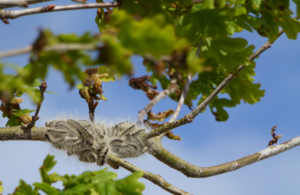Public urged to report sightings of the tree pest oak processionary moth
Defra and the Forestry Commission launch new grant pilot to help landowners tackle the pest

Credit - Forestry Commission
The Forestry Commission has today urged the public to report sightings of oak processionary moth caterpillars. We are now entering the greatest risk period as the caterpillars emerge between May and July to feed before turning into adult moths.
Oak processionary moth, which is a tree pest, was first identified in London in 2006 and has since spread to some surrounding counties in the South East of England. Its caterpillars and their nests contain hairs which can cause itchy rashes, eye and throat irritations, and should not be touched under any circumstances.
Oak processionary moth caterpillars also feed on the leaves of several species of oak trees. This can cause the trees to lose their leaves, negatively impacting their growth, and become more vulnerable to other stresses, like drought.
Andrew Hoppit, Oak Processionary Moth Project Manager, said:
At this time of year, many of us enjoy being outdoors in green spaces of all kinds. If you live in London and the surrounding areas, it’s really important for you to be aware of the health risks posed by tree pests like oak processionary moth.
Any sightings should be reported to the Forestry Commission via our TreeAlert portal. Alternatively, you can email opm@forestrycommission.gov.uk or call 0300 067 4442.
Professor Nicola Spence, UK Chief Plant Health Officer, said:
Reporting any sightings of oak processionary moth to the Forestry Commission will help to protect people, minimise the pest’s spread and help ensure our precious oak trees remain a much loved feature of the landscape.
The caterpillars and their nests can pose a health risk to the public because of their hairs. I would urge the public not to touch them, and for pets and livestock to be kept away.
In addition, Defra, together with the Forestry Commission, is set to launch a grant as part of the Tree Health Pilot to help tackle oak processionary moth. Open to applications from Wednesday 18 May, the OPM Groups Grant will fund the surveying of oak trees within local communities in London and the South East, and thus support efforts to better understand the risks and appropriate management of oak processionary moth. To ease the administrative process and encourage cooperative action in local communities, it will pay for a lead facilitator to form a group of local landowners who all need support to tackle the hazardous pest. This builds on existing support and guidance available to help minimise the impact and spread of the pest.
A Government programme to manage oak processionary moth has been in place since 2012. Over the last five years, £10 million has been invested into oak health, including the management of oak processionary moth, as well as research to develop novel control techniques and new policy responses.
How to identify oak processionary moth caterpillars
- Nests are typically dome or teardrop-shaped, averaging the size of a tennis ball. They are white when fresh, but soon become discoloured and brown. The caterpillars have black heads and bodies covered in long white hairs which contain proteins which can cause itchy rashes, eye, and throat irritations. They can also occasionally cause breathing difficulties in people and pets, so should not be touched under any circumstances.
- A public information leaflet covering how to identify OPM and methods of control is available here.
- For more information, visit ‘Managing Oak Processionary Moth in England’.
Further information:
- Following possible oak processionary moth (OPM) contact, visit your pharmacist for relief from milder skin or eye irritations. Consult a GP or call NHS111 for more serious reactions. Contact a vet if animals are seriously affected.
- An interactive map showing the locations of recent confirmed reports of OPM and the national management zones is available.
- A toolkit for local authorities and larger landowners to help plan for and manage OPM has been developed by the Tree Council, in partnership with Forest Research.